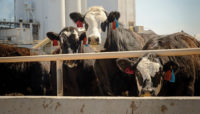Cover Story
Beef Products Inc. (BPI): Supplementing supply
With increasing demand for lean beef and shrinking supply driving growth at Beef Products Inc. (BPI), the company has continued to invest in making its processes even more sustainable.


BPI’s utility building gives the company a sustainable edge through heat reclamation and storage from cooling water and a geothermal heat system that cools the South Sioux City, Neb., facility’s refrigeration system.
PHOTOS BY CRAIG LEE STUDIOS

Brian Goeden (seated), systems engineering director for BPI, shows Andy Hanacek, editor-in-chief of The National Provisioner, the myriad systems and data points he analyzes and monitors on a daily basis at BPI’s South Sioux City plant.
PHOTOS BY CRAIG LEE STUDIOS

Jay Williams, plant coordinator for BPI’s South Sioux City plant (right), explains to Hanacek how the process for producing lean finely textured beef has not changed from its tried-and-true operation, other than becoming more efficient and sustainable overall.
PHOTOS BY CRAIG LEE STUDIOS

Hanacek and Craig Letch, director of quality assurance for BPI, tour the inner workings of BPI’s utility building at its South Sioux City facility.
PHOTOS BY CRAIG LEE STUDIOS





It’s hard to keep a good thing down.
Today, Beef Products Inc. (BPI) finds itself providing a much-needed product to the beef supply chain — one that hasn’t changed despite a campaign of misinformation that BPI contends was brought against it by ABC News in March 2012 and spread by social- and consumer-media activists.
“The consumer today demands nutritious, safe, cost-effective lean beef, and that’s exactly what we bring to the table,” explains Jeff Carlson, assistant director of sales and marketing for BPI. “Today, we are still making the same high-quality lean beef that we always have, and putting it out in the marketplace.”
Despite the misinformed attack on lean finely textured beef (LFTB) in 2012 (which is currently the subject of a $1.2 billion defamation lawsuit in South Dakota state court), BPI never stopped offering the product as a sustainable, safe and high-quality product to customers who use it in their grinds. Furthermore, consumers never really stopped demanding lean ground beef, says Mike Hesse, director of sales and marketing for BPI — the markets simply couldn’t supply it.
“You could see it at the retail level in the months following March 2012,” he says. “There simply were fewer offerings for leaner ground beef, and there were [higher-fat] ground-beef offerings on the shelf.”
Carlson adds that, without LFTB, the supply of lean grinds — and the price — would become unattainable for most consumers.
“Prior to March 2012, you not only were able to buy 90% lean ground beef and 93% lean ground beef, but you also were able to buy 96% lean ground beef,” he says. “Without the utilization of lean beef trimmings, those ground-beef producers simply aren’t able to hit those lean points and [consumers] can’t find it in certain marketplaces on the shelves — and if the product is there, it’s unfortunately priced out of most consumers’ budgets.”
As a result, sales have rebounded on LFTB over the past 26 months, as ground-beef producers look to answer consumer demand. Although BPI hasn’t climbed all the way back to the level of business it had been doing prior to the attack on LFTB, the company reports that it has more than doubled its sales of the product from the low point in 2012.
Meanwhile, the company stresses that it has never wavered from its process, Hesse says. Furthermore, the growing demand for domestic beef — spurred on by country-of-origin labeling regulations — has given LFTB a boost.
“We are a product of the U.S.A., so we can supply that lean beef and meet those requirements,” he says. “And it’s fair to say that the consistency and quality of our LFTB product has always been the same.”
Market conditions are the only difference, in Hesse’s opinion, and those conditions have improved in LFTB’s favor.
“There is still a good demand for ground beef because beef is such a great protein, but what we’re seeing, especially at the retail level, is that more and more consumers that used to buy steaks are now buying grinds,” he says. Record-high prices for beef, and in particular lean ground beef, have showed no sign of dropping as 2014 reached its halfway point at presstime.
“The business model we have had for the last 20 to 30 years continues to make more sense than ever, and lean finely textured beef also makes more sense than it ever has before for the industry, based not only off demand, but also off beef supply,” Hesse says.
Improved sustainable practices
LFTB always has been viewed as a boost to the goal of sustainable beef supply, but that doesn’t mean BPI hasn’t researched and incorporated innovation and improvements to the process. The company always touted the safety and sustainability of the product itself — in fact, the company’s Web site, BeefisBeef.com, talks about how LFTB helps the industry save limited resources and reduces the need for cattle by 1.5 million head annually.
Like any good business, BPI never stops looking for ways to improve efficiencies in its business model and production process, and is willing to invest where necessary. As such, the past few years have brought about some significant improvements at BPI’s production facility in South Sioux City, Neb.
“There’s definitely a cost associated with any improvements, but as we’ve done with our business since Eldon and Regina [Roth] founded it, we’ve reinvested in the company and made those investments in sustainable practices,” explains Hesse. “We don’t stress over the short term; we’re a long-term strategy company.”
|
BPI updates status of Kansas facility
Breaking news on the resumption of the collection of fresh beef trimmings at BPI’s Garden City, Kan., facility.
|
To that end, BPI took on a large-scale project focused on recapturing and reusing heat from its process water several years ago — constructing a multi-story building dedicated to energy capture, storage and recycling at its South Sioux City plant. Brian Goeden, systems engineering director for BPI, explains that processing demand called for the company to make a significant investment, and the utility building was born.
“We did a lot of these [sustainability] things before that building was in place, we simply realized that within the existing walls of the facility, we couldn’t do as much as we wanted or needed at this point,” he explains. “We needed additional utility capacity, more compressed air, more water capacity and so on; the utility building was designed with all of the heat-recovery agenda in mind.”
The building includes water storage tanks, heat exchangers and a geothermal system that allows BPI to significantly cut its dependence upon energy inputs to heat and cool water and processing equipment in its facility. Rather than using energy to heat water for sanitation, BPI captures heated water from its processes and stores it in the large tanks outside the utility building, minimizing the amount of BTUs needed to get the water to the proper sanitation temperature.
“One of our finished products is high-quality edible tallow, and during that process, we cool that tallow down using soft water, which is then captured and stored, and then heated at the time of sanitation the last few desired degrees,” Goeden explains. “There are hundreds and hundreds of heat exchangers, motors, gearboxes and equipment that require water-cooling, and instead of letting those BTUs go down the drain with the water, we’re leaving the heat in the water, saving it and using that water later for cleaning, in most cases.”
Goeden estimates that BPI recovers as much as 90 percent by volume of the water it uses for cooling processes. Furthermore, BPI monitors and recovers boiler condensates and slipstream water from the production of RO (reverse osmosis) water for use in cooling variable-frequency drives, motors and gearboxes in the facility.
One of the biggest savings BPI has encountered from its utility building, however, emanates from the geothermal system it constructed as part of the expansion. Goeden states that the consistent geothermal heat source provides a thermal heat sink for cooling BPI’s approximately 9,000-horsepower refrigeration system, and has produced an estimated 39 percent reduction in overall electricity requirements for the facility.
“First, it gave us additional [refrigeration] capacity without having to add more refrigeration compressors or more horsepower,” Goeden says, “and second, it gave us a constant capacity that wasn’t weather-related.”
Once BPI’s geothermal system allowed it to rely on 50-degree groundwater to cool its refrigeration compressors year-round, rather than the outside air temperature, which can vary wildly from winter to summer, Goeden says the company could move on to bigger and better analysis of its day-to-day energy loads.
When BPI first started the geothermal system, it also began cycling the cooling periods for its freezers and storage rooms to be more in line with the preferences of its electricity supplier, offsetting its own electricity loads to help the utility company minimize demand during peak times. Goeden says this scheduling initiative helped save South Sioux City residents more than $1 million in electricity demand charges.
Today, BPI continues to work with the city to schedule production and cooling times.
“Not only do we cool rooms more aggressively at night or early in the morning and then back things off during the afternoons in the summer — and do the opposite in the winter — but we also schedule our production around that as well, which has taken some time to learn how to adjust properly,” Goeden says. “The peak city loads for South Sioux City were hitting just shy of 50 megawatts at peak demand in the summer before this, and the peak demand last year I believe was in the area of 36 megawatts — that 14-megawatt difference is millions of dollars saved for everyone involved.”
Moving forward
BPI recently gained acceptance into the Global Roundtable for Sustainable Beef, giving it a first-class ticket to help the industry determine the global standards for what it means to be sustainable for beef processors and producers. Given the strides it has made thus far in its own history, and the base of knowledge it can contribute, it should come as little surprise that BPI was accepted. Hesse says BPI is ready to contribute to the group.
“The biggest thing is, we want to be involved and engaged in conversations around what sustainable beef means, so we’re working with the organization that we believe has the strongest foothold and support,” Hesse says.
Craig Letch, director of quality assurance for BPI, agrees, and adds that benefits of BPI’s membership in the roundtable group go both ways.
“What voice can we lend to the organization to communicate our best practices, and then what can we glean from the group that could have long-term impacts upon our production practices?” he asks. “It’s that sharing of information that benefits all.”
Given the sustainability-oriented improvements BPI has made in the past couple years, the company ought to have plenty to share with its roundtable peers moving forward.
And as the demand for lean beef continues to grow, BPI will continue to apply its in-house and acquired knowledge to supply the unique products that contribute to keeping products available to consumers who want them at a price they can afford to pay.
With increasing demand for lean beef and shrinking supply driving growth at Beef Products Inc. (BPI), the company has continued to invest in making its processes even more sustainable.
Looking for a reprint of this article?
From high-res PDFs to custom plaques, order your copy today!











